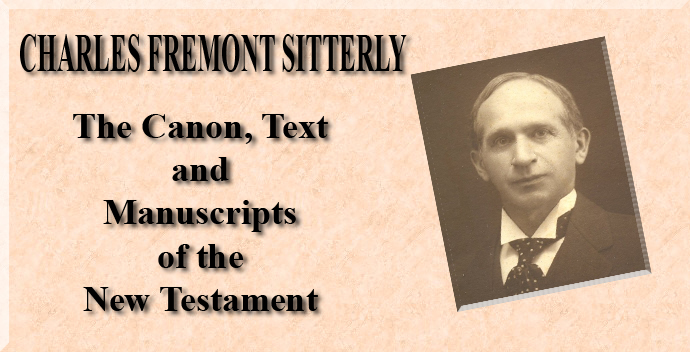
The Canon, Text, and Manuscripts of the New Testament
By Charles Fremont Sitterly
PART I - THE CANON OF THE NEW TESTAMENT
Traced from the latest Version of the English Bible through the Latin and Greek to the original writers
Chapter 1
The Canon of the English New Testament
|
Taking up the New Testament as it is handed down to us in the most recent vernacular version, we find that despite all of the advances made in other respects, at least in the matter of the scope of the canon there has been no disposition either to restrict or extend the list of New Testament books as contained in what has been known for the past three centuries as the Authorized Version of the English Bible. Turning to the Rheims New Testament, which is the well-known English rendering authorized by the Roman Catholic Church, and which precedes that of 1611 by thirty years, we find precisely the same order and number of books. The same is true of the Bishops' Bible, published in 1568, and which was the model of the Authorized Version; of the Great Bible of 1539, which was the model of the Bishops' and of Tyndale's New Testament, first published at Worms in 1525. This takes us back to the land and the time of the beginning of printed books. _ Besides the quaint forms of spelling in Tyndale's titles to New Testament books, as Marke, Jhon, Romaynes, Hebrues, etc., it is interesting to note that he called only the first four of the Pauline writings epistles, the remaining books being styled "Pistles." Now for nearly a century and a half prior to Tyndale the New Testament in English had been circulated in manuscript form. By the year 1380 Wycliffe had completed his translation, into middle English, of the New Testament, and although it was not put forth in printed form until 1848, yet it was so highly appreciated and widely multiplied that even to-day more than one hundred and fifty manuscripts of Wycliffe's version are extant. Although neither John Wycliffe nor John Purvey, his able successor, admitted any more or any other than the usual twenty-seven books, yet it is important to note that another book was included in some later copies of their New Testament. This is the Epistle to the Laodicenes, a Latin compilation dating from the sixth century and not to be confused with the celebrated Greek Epistle of the same name current in the post-apostolic age.
|
|
 |
 |
|
|
|
-
Site Navigation
 Home
Home What's New
What's New Bible
Bible Photos
Photos Hiking
Hiking E-Books
E-Books Genealogy
Genealogy Profile
Free Plug-ins You May Need
Profile
Free Plug-ins You May Need
 Get Java
Get Java.png) Get Flash
Get Flash Get 7-Zip
Get 7-Zip Get Acrobat Reader
Get Acrobat Reader Get TheWORD
Get TheWORD